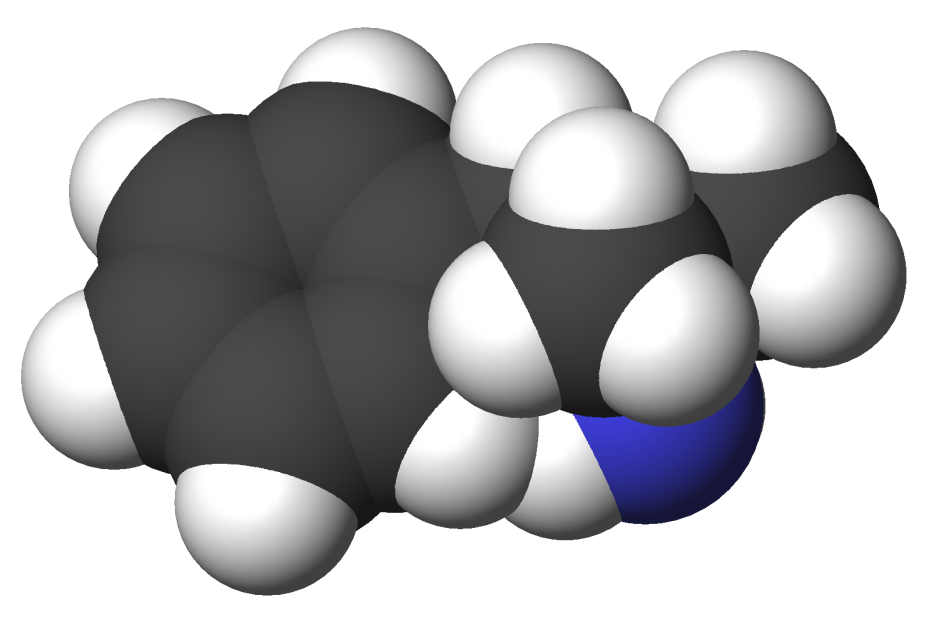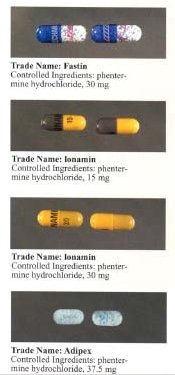Phentermine
 | |
 | |
| Clinical data | |
|---|---|
| Pregnancy category |
|
| Routes of administration | Oral |
| ATC code | |
| Legal status | |
| Legal status |
|
| Pharmacokinetic data | |
| Bioavailability | Peak plasma levels occur within 1 to 4.5 hours. Absorption is usually complete by 4 to 6 hours |
| Protein binding | Approximately 96.3% |
| Metabolism | hepatic |
| Elimination half-life | 16 to 31 hours |
| Excretion | Urinary elimination |
| Identifiers | |
| |
| CAS Number | |
| PubChem CID | |
| DrugBank | |
| E number | {{#property:P628}} |
| ECHA InfoCard | {{#property:P2566}}Lua error in Module:EditAtWikidata at line 36: attempt to index field 'wikibase' (a nil value). |
| Chemical and physical data | |
| Formula | C10H15N |
| Molar mass | 149.233 g/mol |
|
WikiDoc Resources for Phentermine |
|
Articles |
|---|
|
Most recent articles on Phentermine Most cited articles on Phentermine |
|
Media |
|
Powerpoint slides on Phentermine |
|
Evidence Based Medicine |
|
Clinical Trials |
|
Ongoing Trials on Phentermine at Clinical Trials.gov Clinical Trials on Phentermine at Google
|
|
Guidelines / Policies / Govt |
|
US National Guidelines Clearinghouse on Phentermine
|
|
Books |
|
News |
|
Commentary |
|
Definitions |
|
Patient Resources / Community |
|
Patient resources on Phentermine Discussion groups on Phentermine Patient Handouts on Phentermine Directions to Hospitals Treating Phentermine Risk calculators and risk factors for Phentermine
|
|
Healthcare Provider Resources |
|
Causes & Risk Factors for Phentermine |
|
Continuing Medical Education (CME) |
|
International |
|
|
|
Business |
|
Experimental / Informatics |
Editor-In-Chief: C. Michael Gibson, M.S., M.D. [1]
Please Take Over This Page and Apply to be Editor-In-Chief for this topic: There can be one or more than one Editor-In-Chief. You may also apply to be an Associate Editor-In-Chief of one of the subtopics below. Please mail us [2] to indicate your interest in serving either as an Editor-In-Chief of the entire topic or as an Associate Editor-In-Chief for a subtopic. Please be sure to attach your CV and or biographical sketch.
For patient information, please click here
Overview
Phentermine is an appetite suppressant of the amphetamine and phenethylamine class.
It is approved as an appetite suppressant to help reduce weight in obese patients when used short-term and combined with exercise, diet, and behavioral modification. It is typically prescribed for individuals who are at increased medical risk because of their weight and works by helping to release certain chemicals in the brain that control appetite.
Commercial trade names
- Adipex P (Immediate release)
- Anoxine-AM®
- Fastin®
- Ionamin® (Slow Release Resin, Australia)
- Duromine® (Slow Release Resin, New Zealand)
- Obephen®
- Obermine®
- Obestin-30®
- Phentrol®
- Pro-Fast SA
- Redusa
- Panbesy
- Phentermine Trenker
- Obenix
- Oby-Trim
History
In 1959 phentermine first received approval from the FDA as an appetite suppressing drug. Phentermine hydrochloride then became available in the early 1970s. It was previously sold as Fastin® from King Pharmaceuticals for SmithKline Beecham, however in 1998 it was removed from the market. Medeva Pharmaceuticals sells the name brand of phentermine called Ionamin® and Gate Pharmaceuticals sells it as Adipex-P®. Phentermine is also currently sold as a generic. Since the drug was approved in 1959 there have been almost no clinical studies performed. The most recent study was in 1990 which combined phentermine with fenfluramine or dexfenfluramine and became known as Fen-Phen.
A study was published in 1992 that Fen-Phen was more effective than diet and exercise with few side effects. However, in 1997 after 24 cases of heart valve disease in Fen-Phen users, fenfluramine and dexfenfluramine were voluntarily taken off the market at the request of the FDA. Studies later proved that nearly 30% of people taking fenfluramine or dexfenfluramine had abnormal valve findings. The FDA did not ask manufacturers to remove phentermine from the market.
Phentermine is still available by itself in most countries, including the U.S. However, because it is similar to amphetamines, individuals may develop an addiction to it. Hence, it is classified as a controlled substance in many countries. Internationally, phentermine is a schedule IV drug under the Convention on Psychotropic Substances.[1] In the United States, it is classified as a Schedule IV controlled substance under the Controlled Substances Act.
Mechanism of action

Phentermine, like many other prescription drugs, works with neurotransmitters in the brain. It is a centrally-acting stimulant and is a constitutional isomer (not to be confused with stereoisomer) of methamphetamine. It stimulates neuron bundles to release a particular group of neurotransmitters known as catecholamines; these include dopamine, epinephrine (also known as adrenalin), and norepinephrine (noradrenaline). The anorectic activity seen with these compounds would thus seem likely due to this effect on the central nervous system, which is consistent with current knowledge about central nervous system systems and feeding behavior. This is the same mechanism of action as other stimulant appetite suppressants such as diethylpropion and phendimetrazine. The neurotransmitters signal a fight-or-flight response in the body which, in turn, puts a halt to the hunger signal. As a result, it causes a loss in appetite because the brain does not receive the hunger message.
Dosing and administration
Generally, it is recommended by the Food and Drug Administration (FDA) that phentermine should be used short-term (usually interpreted as 'up to 12 weeks'), while following nonpharmacological approaches to weight loss such as healthy dieting and exercise. However, recommendations limiting its use for short-term treatment may be controversial. One reason given behind limiting its use to 12 weeks is drug tolerance, whereby phentermine loses its appetite-suppressing effects after the body adjusts to the drug. On the contrary, it has been shown that phentermine did not lose effectiveness in a 36-week trial.[2] Due to the risk of insomnia, it is generally recommended that the drug be taken either before breakfast or 1-2 hours after breakfast.
Contraindications and warnings
- Patients with the following should not use Phentermine:
- An allergy to any ingredient in Phentermine or other sympathomimetics (eg, pseudoephedrine)
- Are also taking dexfenfluramine, fenfluramine, furazolidone, guanadrel, guanethidine, or have taken a monoamine oxidase inhibitor (MAOI) (eg, phenelzine) in the last 14 days
- Have moderate to severe high blood pressure, an overactive thyroid, glaucoma, heart or blood vessel disease, or severe narrowing of the blood vessels
- Are in an agitated state, or have a history of substance abuse
- Some medical conditions may interact with Phentermine, patients with the following should consult with their doctor before using phentermine:
- Are pregnant, planning to become pregnant, or are breast-feeding
- Are taking any prescription or nonprescription medicine, herbal preparation, or dietary supplement
- Have allergies to medicines, foods, or other substances
- Have a brain or spinal cord disorder, hardening of the arteries, high blood pressure, diabetes, or high cholesterol or lipid levels
- Some medicines may interact with Phentermine, such as the following:
- Dexfenfluramine, fenfluramine, furazolidone, or MAOIs (eg, phenelzine) because the risk of serious side effects, such as increasing headache, high blood pressure, slow heart rate, elevated temperature, or possibly fatal lung problems, may be increased
- Serotonin specific reuptake inhibitors (eg, fluoxetine) because the risk of their side effects may be increased by Phentermine
- Guanadrel or guanethidine because their effectiveness may be decreased by Phentermine
Side effects
Generally, phentermine appears to be relatively well tolerated.[3] It can produce side effects consistent with its catecholamine-releasing properties, e.g., tachycardia (increased heart rate) and elevated blood pressure, but the incidence and magnitude of these appear to be less than with the amphetamines. Because phentermine acts through sympathomimetic pathways, the drug may increase blood pressure and heart rate. It may also cause palpitations, restlessness, and insomnia. Additionally, phentermine has the potential to cause physical and psychological dependence.
More Common Symptoms
- Insomnia
- Increased blood pressure
- Irritability
- Nervousness
- Sense of well-being
Less Common to Rare Symptoms
- Blurred vision
- Change in sexual desire
- Clumsiness
- Confusion
- Diarrhea
- Dizziness
- Dry mouth
- Headache
- Irregular heartbeat
- Nausea or vomiting
- Psychosis
- Skin rash or itching
- Stomach pain
- Tiredness
- Unpleasant taste
Possible Overdose Symptoms
- Confusion
- Convulsions (seizures)
- Dizziness
- Fast Breathing
- Fever
- Hallucinations
- Hostility with urge to attack
- Irregular blood pressure
- Irregular heartbeat
- Lightheadedness or Fainting
- Depression, following a period of excitement
- Tremors, Trembling, or Shaking
- Overactive Reflexes
- Panic
- Restlessness
- Severe [[nausea], vomiting or [[diarrhea]
- Stomach cramps
- Tiredness or Weakness
References
- ↑ Incb.org (PDF file)
- ↑ PMID 11054601
- ↑ Nelson DL, Gehlert DR. (2006). "Central nervous system biogenic amine targets for control of appetite and energy expenditure" (HTML). Endocrine. 2006 Feb;29(1):49-60. PubMed. Retrieved 6 May. Unknown parameter
|accessyear=ignored (|access-date=suggested) (help); Check date values in:|accessdate=(help)
External links
- MedLine Plus - Phentermine
- International Programme on Chemical Safety - Phentermine
- TOXNET
- DrugBank:Phentermine
Template:Phenethylamines
Template:Stimulants
Template:Antiobesity preparations
Template:SIB
- Pages with script errors
- Pages with citations using unsupported parameters
- CS1 errors: dates
- Drugs with non-standard legal status
- E number from Wikidata
- ECHA InfoCard ID from Wikidata
- Articles without EBI source
- Chemical pages without ChemSpiderID
- Articles without KEGG source
- Articles without InChI source
- Articles without UNII source
- Articles containing unverified chemical infoboxes
- Anorectics
- Phenethylamines
- Stimulants
- Endocrinology